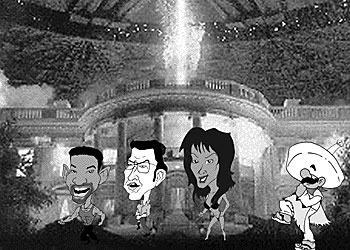
Illustration by Arnulfo Bermudez
|
By Bill Wetzel
Arizona Daily Wildcat
Friday January 31, 2003
There is a novel idea out on the horizon of public school education.
Education might actually be about students after all.
Here in Arizona, the Tucson Unified School District has implemented four discernible ethnic studies departments, including African-American, Pan-Asian-American, Native American and, most recently, Mexican-American/Raza.
Mexican-American/Raza studies is believed to be the first Hispanic studies department of its kind in any United States public school district.
For minority students, these programs instill personal meaning and self-enrichment to courses they otherwise would have trouble relating to and identifying with. This infusion of minority culture has ascended in the hope of curbing drop-out rates, while increasing academic success among a student demographic that has a history of academic struggle and underachievement. The broadened implementation of specific racial and ethnic studies programs are a step in the right direction toward properly educating America's youth as a whole.
These are all extremely exciting and important developments, all of which have been a long time in the making in the U.S. educational system. At the same time, however, the permeation of minority culture and values into the educational process is only one important phase of America's racial and ethnic education. Minority culture transcends the minority population and educational system, and therefore needs to be interspersed into mainstream pop culture as well.
Since the time some guy named Columbus inadvertently "discovered" the New World, European culture has dominated the entire realm of historical perspective. As young elementary school children, all of America has grown up learning an autocratic culture of eurocentricities ÷ the telling of history through the eyes of Europeans.
Through eurocentricities we, as a nation, have learned about the fictional taming of the West. The false European building of railroads. The defeat and assimilation of wild, savage Indians. The concept of black people being truly free once Lincoln abolished slavery.
These are all one-dimensional perspectives that live on in mainstream culture and education, albeit in varying degrees, to this very day. Literature and film often tell stories of racial myth. Often times they reiterate generations of stereotypes, presumed to be factual. Just watch the movie "Independence Day," a major Hollywood blockbuster that not so long ago racked in hundreds of millions of dollars.
In this film, one can watch the young athletic black man, played by Will Smith, fight aliens with brawn rather than his brains. Vivica A. Fox, a young black woman, has an out of wedlock child from a previous relationship and dances in a strip club for a living. Let us not forget the financially secure, intelligent Jew, Jeff Goldblum. He utilizes brains and computer skills to battle the aliens. We also have a crazy, alcoholic, Hispanic/American Indian war veteran, Randy Quaid, driving around in a trashy mobile home with a slew of motherless kids. In addition, there is the scene when all those people in Africa run out of the brush, half-naked in loincloths, waving spears around in jubilant victory after the aliens over their country were overwhelmed. Rampant stereotypes in this vein are all too common in mainstream pop culture.
Dispelling mythical racial and ethnic ideologies begins early in a child's education and continues through the integration into mainstream American culture, as well. Minority cultures need not only be infused in the lives of minorities, but in the lives of the European descendants they co-exist with in this country with. In that regard, this continuity of education lies in the hands of minority artists who need to work in conjunction with America's educators to properly depict race and ethnicity in the mass populace.
It is important for the youth of America to discover themselves through the histories of their own people and, equally important, in areas of co-inhabitation by different cultures in order to gain knowledge of the cultural variation in the same manner. Incognizance breeds rancor and there is no excuse for Americans to be unaware and ill prepared for cultural diversity ÷ such diversity will dispel myth, reduce prejudice and look toward the healthy growth of our current and future generations.
Famed American Indian author D'arcy McNickle once said that the first purpose of education in any society is to provide competent adults to carry society into the future. American public education must be ethnically reformed.

